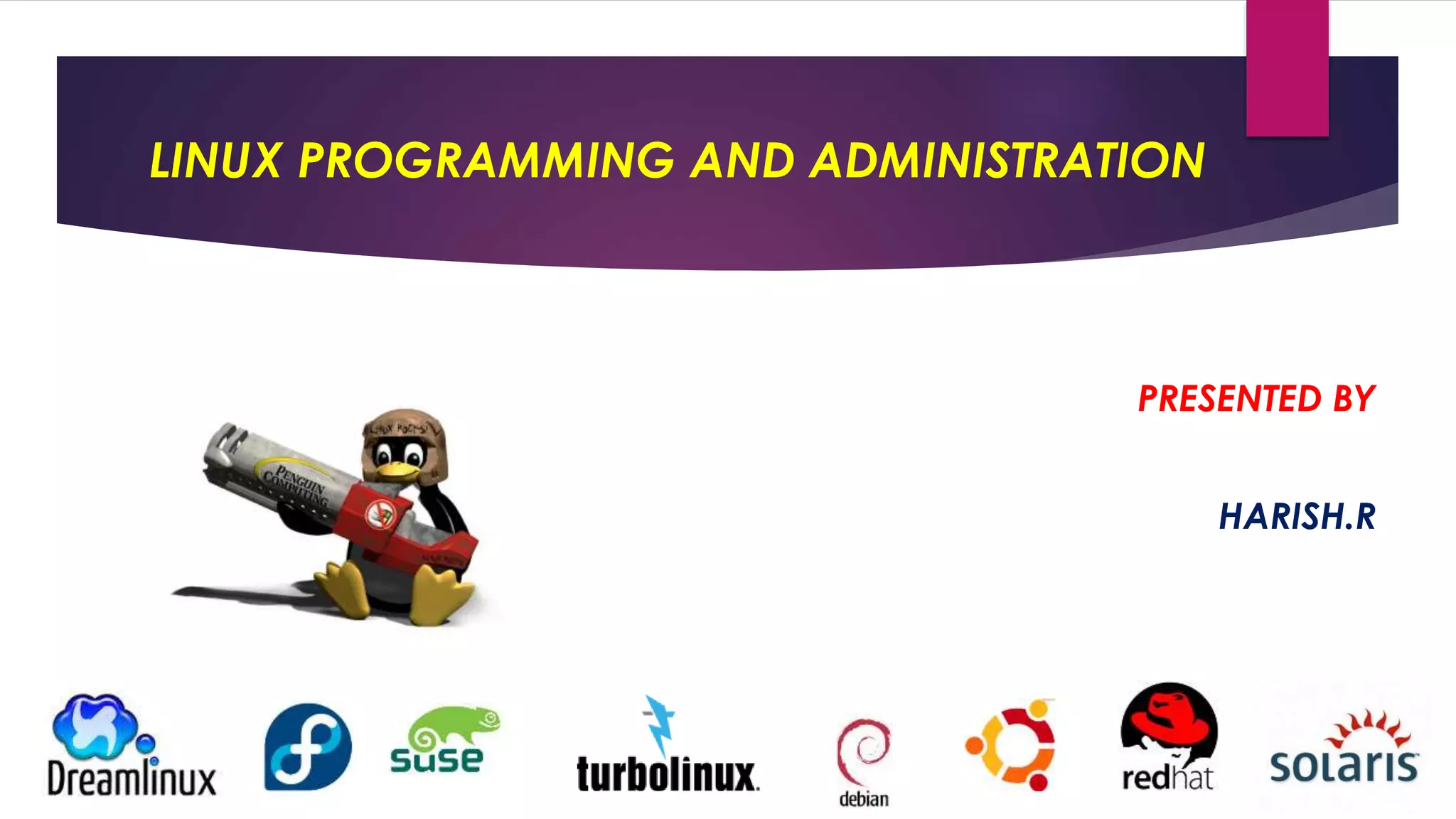This document provides an overview of a presentation on Linux programming and administration. It covers the history of Unix and Linux, files and directories in Linux, Linux installation, basic Linux commands, user and group administration, and LILO (Linux Loader). The document introduces key topics like Unix flavors, Linux distributions, partitioning and formatting disks for Linux installation, the file system hierarchy standard, and access permissions in Linux.






















![ Used as a location to place data temporarily if RAM memory becomes full.
Red Hat automatically creates this partition and usually makes it about twice
the amount of system RAM.
To create swap partition
]#fdisk /dev/partition name
N=new
L=logical](https://image.slidesharecdn.com/linux-150331103447-conversion-gate01/75/Introduction-to-Linux-23-2048.jpg)
![Format swap
]#mkswap /dev/partition name and ID
To on the swap
]#swapon /dev/partition name and ID](https://image.slidesharecdn.com/linux-150331103447-conversion-gate01/75/Introduction-to-Linux-24-2048.jpg)
















![Print working directory
Print the name of the current working directory
[root@comp~]# pwd](https://image.slidesharecdn.com/linux-150331103447-conversion-gate01/75/Introduction-to-Linux-41-2048.jpg)
![List of files and directories
Options:
-l Long list including attributes
-a All files and directories including hidden.
-d For a particular file or directory.
-R Recursive to see the tree.
To see the list of files and folders
[root@comp~]# ls <options> <arguments>](https://image.slidesharecdn.com/linux-150331103447-conversion-gate01/75/Introduction-to-Linux-42-2048.jpg)

![Cat (concatenation command)
To create a file
[root@comp~]# cat > <filename>
To view the contents of the file
[root@comp~]# cat <filename>](https://image.slidesharecdn.com/linux-150331103447-conversion-gate01/75/Introduction-to-Linux-44-2048.jpg)
![Touch command
To create a zero byte file
[root@comp~]# touch <filename>
To create a multiple zero byte file
[root@comp~]# touch <first file> <second file> <third file>](https://image.slidesharecdn.com/linux-150331103447-conversion-gate01/75/Introduction-to-Linux-45-2048.jpg)
![Vi editor
To create a file
[root@comp~]# vi <filename>](https://image.slidesharecdn.com/linux-150331103447-conversion-gate01/75/Introduction-to-Linux-46-2048.jpg)
![Creating a directories
To create multiple directories
[root@comp~]# mkdir <first dir> <second dir> <third dir>
To create a directory
[root@comp~]# mkdir <file name>](https://image.slidesharecdn.com/linux-150331103447-conversion-gate01/75/Introduction-to-Linux-47-2048.jpg)
![Copying
Options:
-r Recursive
-v Verbose
-p Copy with permissions
To copying a file or directory
[root@comp~]# cp <options> <source file> <destination file>](https://image.slidesharecdn.com/linux-150331103447-conversion-gate01/75/Introduction-to-Linux-48-2048.jpg)
![Moving and renaming
To move a file or directory to a different locations
[root@comp~]# mkdir <source file or directory> <destination>
Rename a file or directory
[root@comp~]# mv <old name> <new name>](https://image.slidesharecdn.com/linux-150331103447-conversion-gate01/75/Introduction-to-Linux-49-2048.jpg)
![Deleting
Options
-r Recursive
-f forcefully
To remove or delete an empty directory
[root@comp~]# rmdir <dir name>
To remove or delete a file or directory
[root@comp~]# rm <options> <file or dir name>](https://image.slidesharecdn.com/linux-150331103447-conversion-gate01/75/Introduction-to-Linux-50-2048.jpg)
![Other commands
To see the date
[root@comp~]# date
To see the calender
[root@comp~]# cal](https://image.slidesharecdn.com/linux-150331103447-conversion-gate01/75/Introduction-to-Linux-51-2048.jpg)










![Users
When a user is created in UNIX and LINUX, the following are also created by
default.
Home directory /home/[username]
Mail account /var/spool/mail/[username]
Unique user identifier (UID) and the Group Identifier (GID).](https://image.slidesharecdn.com/linux-150331103447-conversion-gate01/75/Introduction-to-Linux-62-2048.jpg)
![Creating a user
Adding a user
[root@comp~]# useradd <username>
Or
[root@comp~]# useradd <options> <arguments> <username>](https://image.slidesharecdn.com/linux-150331103447-conversion-gate01/75/Introduction-to-Linux-63-2048.jpg)

![User password
Creating or changing a user password
[root@comp~]# passwd <username>](https://image.slidesharecdn.com/linux-150331103447-conversion-gate01/75/Introduction-to-Linux-65-2048.jpg)
![Modifying a user
Options:
-l Change the login name.
-L Lock the account.
-U Unlock the account.
Modifying user properties
[root@comp~]# usermod <options> <arguments> <username>](https://image.slidesharecdn.com/linux-150331103447-conversion-gate01/75/Introduction-to-Linux-66-2048.jpg)
![Deleting a user
Options:
-r Recursively
Deleting a user
[root@comp~]# userdel <options> <arguments> <username>](https://image.slidesharecdn.com/linux-150331103447-conversion-gate01/75/Introduction-to-Linux-67-2048.jpg)


![Creating a group
Options:
1. -g GID
Creating a group
[root@comp~]# groupadd <group name>
Or
[root@comp~]# groupadd <options> <arguments> <group name>](https://image.slidesharecdn.com/linux-150331103447-conversion-gate01/75/Introduction-to-Linux-70-2048.jpg)
![Modifying a group
Options:
-g GID
-n Group Name
Modifying a group
[root@comp~]# groupmod <options> <arguments> <group name>](https://image.slidesharecdn.com/linux-150331103447-conversion-gate01/75/Introduction-to-Linux-71-2048.jpg)
![Deleting a group
Deleting a group
[root@comp~]# groupdel <options> <arguments> <username>](https://image.slidesharecdn.com/linux-150331103447-conversion-gate01/75/Introduction-to-Linux-72-2048.jpg)


















